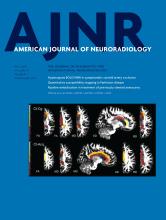Research ArticlePediatric Neuroimaging
Quantitative Assessment of Neovascularization after Indirect Bypass Surgery: Color-Coded Digital Subtraction Angiography in Pediatric Moyamoya Disease
H.-H. Cho, J.-E. Cheon, S.-K. Kim, Y.H. Choi, I.-O. Kim, W.S. Kim, S.-M. Lee, S.K. You and S.-M. Shin
American Journal of Neuroradiology May 2016, 37 (5) 932-938; DOI: https://doi.org/10.3174/ajnr.A4614
H.-H. Cho
aFrom the Department of Radiology (H.-H.C., J.-E.C., Y.H.C., I.-O.K., W.S.K., S.-M.L., S.K.Y.), Seoul National University Hospital, Seoul, Korea
J.-E. Cheon
aFrom the Department of Radiology (H.-H.C., J.-E.C., Y.H.C., I.-O.K., W.S.K., S.-M.L., S.K.Y.), Seoul National University Hospital, Seoul, Korea
bDepartment of Radiology (J.-E.C., Y.H.C., I.-O.K., W.S.K.), Seoul National University College of Medicine, Seoul, Korea
cInstitute of Radiation Medicine (J.-E.C., I.-O.K., W.S.K.), Seoul National University Medical Research Center, Seoul, Korea
S.-K. Kim
dDivision of Pediatric Neurosurgery (S.-K.K.), Seoul National University Children's Hospital, Seoul, Korea
Y.H. Choi
aFrom the Department of Radiology (H.-H.C., J.-E.C., Y.H.C., I.-O.K., W.S.K., S.-M.L., S.K.Y.), Seoul National University Hospital, Seoul, Korea
bDepartment of Radiology (J.-E.C., Y.H.C., I.-O.K., W.S.K.), Seoul National University College of Medicine, Seoul, Korea
I.-O. Kim
aFrom the Department of Radiology (H.-H.C., J.-E.C., Y.H.C., I.-O.K., W.S.K., S.-M.L., S.K.Y.), Seoul National University Hospital, Seoul, Korea
bDepartment of Radiology (J.-E.C., Y.H.C., I.-O.K., W.S.K.), Seoul National University College of Medicine, Seoul, Korea
cInstitute of Radiation Medicine (J.-E.C., I.-O.K., W.S.K.), Seoul National University Medical Research Center, Seoul, Korea
W.S. Kim
aFrom the Department of Radiology (H.-H.C., J.-E.C., Y.H.C., I.-O.K., W.S.K., S.-M.L., S.K.Y.), Seoul National University Hospital, Seoul, Korea
bDepartment of Radiology (J.-E.C., Y.H.C., I.-O.K., W.S.K.), Seoul National University College of Medicine, Seoul, Korea
cInstitute of Radiation Medicine (J.-E.C., I.-O.K., W.S.K.), Seoul National University Medical Research Center, Seoul, Korea
S.-M. Lee
aFrom the Department of Radiology (H.-H.C., J.-E.C., Y.H.C., I.-O.K., W.S.K., S.-M.L., S.K.Y.), Seoul National University Hospital, Seoul, Korea
S.K. You
aFrom the Department of Radiology (H.-H.C., J.-E.C., Y.H.C., I.-O.K., W.S.K., S.-M.L., S.K.Y.), Seoul National University Hospital, Seoul, Korea
S.-M. Shin
eDepartment of Radiology (S.-M.S.), Seoul Metropolitan Government–Seoul National University, Boramae Medical Center, Seoul, Korea.

References
- 1.↵
- Kuroda S,
- Houkin K
- 2.↵
- 3.↵
- Suzuki J,
- Takaku A
- 4.↵
- Fukui M
- 5.↵
- Kim SK,
- Wang KC,
- Kim IO, et al
- 6.↵
- 7.↵
- 8.↵
- 9.↵
- Goda M,
- Isono M,
- Ishii K, et al
- 10.↵
- 11.↵
- Choi JU,
- Kim DS,
- Kim EY, et al
- 12.↵
- 13.↵
- Strother CM,
- Bender F,
- Deuerling-Zheng Y, et al
- 14.↵
- Lin CJ,
- Yu M,
- Hung SC, et al
- 15.↵
- 16.↵
- 17.↵
- Suzuki J,
- Kodama N
- 18.↵
- Matsushima T,
- Inoue T,
- Suzuki SO, et al
- 19.↵
- Kim SK,
- Wang KC,
- Kim IO, et al
- 20.↵
- 21.↵
- Houkin K,
- Nakayama N,
- Kuroda S, et al
- 22.↵
- 23.↵
- Ikezaki K,
- Matsushima T,
- Kuwabara Y, et al
- 24.↵
- So Y,
- Lee HY,
- Kim SK, et al
- 25.↵
- Hoshi H,
- Ohnishi T,
- Jinnouchi S, et al
- 26.↵
- 27.↵
- Fujimura M,
- Mugikura S,
- Shimizu H, et al
- 28.↵
- Fung LW,
- Thompson D,
- Ganesan V
- 29.↵
- Sakamoto H,
- Kitano S,
- Yasui T, et al
- 30.↵
- Togao O,
- Mihara F,
- Yoshiura T, et al
- 31.↵
- Kassner A,
- Zhu XP,
- Li KL, et al
- 32.↵
- Kinugasa K,
- Mandai S,
- Kamata I, et al
- 33.↵
- Kim SK,
- Seol HJ,
- Cho BK, et al
In this issue
American Journal of Neuroradiology
Vol. 37, Issue 5
1 May 2016
Advertisement
H.-H. Cho, J.-E. Cheon, S.-K. Kim, Y.H. Choi, I.-O. Kim, W.S. Kim, S.-M. Lee, S.K. You, S.-M. Shin
Quantitative Assessment of Neovascularization after Indirect Bypass Surgery: Color-Coded Digital Subtraction Angiography in Pediatric Moyamoya Disease
American Journal of Neuroradiology May 2016, 37 (5) 932-938; DOI: 10.3174/ajnr.A4614
0 Responses
Quantitative Assessment of Neovascularization after Indirect Bypass Surgery: Color-Coded Digital Subtraction Angiography in Pediatric Moyamoya Disease
H.-H. Cho, J.-E. Cheon, S.-K. Kim, Y.H. Choi, I.-O. Kim, W.S. Kim, S.-M. Lee, S.K. You, S.-M. Shin
American Journal of Neuroradiology May 2016, 37 (5) 932-938; DOI: 10.3174/ajnr.A4614
Jump to section
Related Articles
- No related articles found.
Cited By...
This article has not yet been cited by articles in journals that are participating in Crossref Cited-by Linking.
More in this TOC Section
Pediatric Neuroimaging
Similar Articles
Advertisement











